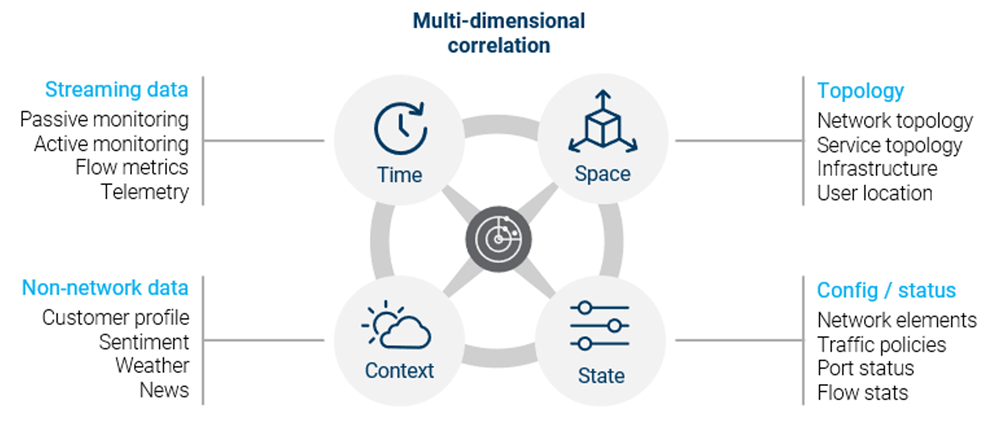5G and artificial intelligence—what does it mean for operators
The role of Artificial Intelligence in 5G network deployment
5G is just starting to scale out. And even though it’s just getting started, 5G adoption is expected to be fast and furious, fueling a 700% increase in network traffic within the next 5 years1. At current traffic volumes, operations teams already access a dozen tools daily to manage network and service performance. And currently, outages take nearly 7 hours2 to resolve, on average. With this dramatic increase in traffic on the horizon, operators need to take a hard look at manual processes and existing systems and make changes now in order to get 5G ready.
In this context of complexity, 9 out of 10 operators say they will deploy real-time network automation within the next 18 months. They say it’s essential to their success in 5G3. They also say real-time data capture and an integrated view from their tools is necessary for automation to succeed. Only 3% of them have that today2.
It’s clear that 5G operations require automated, immediate action to maintain control and optimize dynamic services. And we’re still at the infancy stage of 5G, as diversity and density of traffic will continue to increase exponentially fueled by the wave of machine-based communications that will eclipse human traffic on mobile networks by 20244.
5G service assurance
Do mobile operators need to replace and renew their monitoring tools and rethink their service assurance strategies? Yes.
Do they need to rip and replace? No.
Operations teams need to ensure that the widening visibility gaps introduced by massive traffic volumes, encrypted video and applications and dynamic services are covered by adaptive, active and trace-based monitoring feeds. They also need to embrace AI to overcome big data overhead that can result in precious ‘small data’ get delayed or lost in massive volumes of data.
But this doesn’t replace what they already have: the dozens of essential tools they rely on to get things done. Adding new ways to capture and mine data faster are necessary, but not enough. Gaining a complete view of all services, networks, layers and locations to fuel automation requires one more thing: integration—the essential element 97% of operators say they are missing.
Integration and AI analytics are essential
As long as data sources remain siloed, their collective intelligence can’t be realized. When disparate data is aligned and analyzed as a whole, an entirely new level of detection and diagnostics becomes possible. Overlaying each system’s unique perspective brings insight into focus. Diversity provides unity. And once data is united, AI can extract additional value from existing and new systems alike.
Assuring strong performance and excellent customer experience across the diverse use cases introduced by 5G requires an equally diverse wide range of monitoring data. Each data source contributes unique value. AI-analytics relies on access to these streaming and system data sources to detect anomalies and integrate network state, alarms and environmental context into near-instant root cause diagnosis.
AI-driven data analytics
AI can uniquely reveal the relationships, dependencies, co-occurrence and casualties that reduce seas of alarms to targeted, prioritized actions using multidimensional correlation across space, time, context and state. The key dimensions to align are:
- Time: streaming data from passive and active monitoring, flow metrics and telemetry
- Space: topology of networks and services that relates infrastructure to user location and experience
- Context: non-network data including customer profiles, sentiment, weather and external events
- State: configuration and status of network elements, traffic policies, port and flow statistics
By analyzing diverse data sets across these dimensions, AI can associate events that would otherwise remain isolated across siloed systems. It can reveal the invisible.

Each data source has unique attributes. Here’s how the data from common monitoring tools and operational support systems are leveraged in multi-dimensional correlation and analysis:
Passive monitoring - CDRs / XDRs
Call and data detail records provide customer and device-level insight into QoE, location, services, event impact and transactions.
Active monitoring - QoS / QoE
Consistent, granular metrics provide a real-time pulse of network and service performance from core-to-edge, independent of user device or behavior.
Fiber monitoring - Optical QoS
Effective troubleshooting requires insight into how optical faults and degraded transmission performance impact QoS and QoE.
Topology - Dependencies
Topology helps visualize and isolate fault location using infrastructure dependencies. It enables service impact analysis and event correlation.
Faults / alarms - Diverse alerts
Many alarms don’t relate to QoE. By correlating them with customer impacting events, operations can prioritize actions to optimize business outcomes.
Config / status - State, policy, KPIs
Network element config and status, traffic policies and performance KPIs (flow stats) identify how infrastructure contributes to QoS and QoE.
AI for integrated network insights
We’ve seen how service providers can automate operations and troubleshooting processes by applying AI-analytics to pertinent data sources. Incrementally adding new data sets allows AI to address new use cases.
This means operators can apply an agile approach to automation, starting with scenarios that loom large—for example, automated root cause analysis of interdependent RAN and transport issues to deliver reliable throughput—then tackle new applications by extending the capabilities of their instrumentation and AI-analytics platforms. It’s a sure way to build on today’s tools to meet tomorrow’s goals.
Learn what it takes to employ AI for integrated insight.
References:
1 TMF, “The foundation of intelligent automation”, 2018-10
2 Heavy Reading global study of 150 mobile operators, 2019-07
3 Futurium global operator survey, 2018-12
4 GSMA Intelligence, 2020-08SEO




